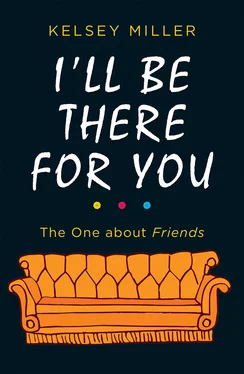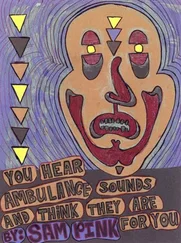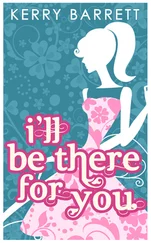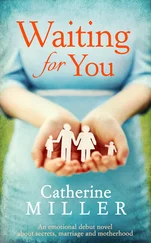I don’t think it’s sad. I think it’s right on the money. I think it’s the very reason Friends remains one of the most-watched shows on television, to this day. A reported 16 million Americans watch the reruns weekly. That’s as many or more viewers than some of the episodes got during Friends ’ first run. And that’s just the people watching it on TV. Netflix has retained the streaming rights since 2015, and since its wildly popular US debut, the company has been rolling out the series to 118 million (and counting) subscribers worldwide. In those markets, too, the Friends fandom remains huge and steady, and in some, it’s actually growing. In 2016, ratings were up by 10% in the UK, where the reruns air on Comedy Central—a channel whose primary demographic is aged 16–34. Teenagers—who weren’t even born when Friends went off the air—lie around on the couch, watching it after school. Young adults come home to their cramped apartments late at night (perhaps still full of street pizza), bring their laptops into bed, and fall asleep to an episode. And not-so-young adults, like me, watch reruns on exercise machines.
Friends has managed to transcend age, nationality, cultural barriers, and even its own dated, unrelatable flaws. Because, underneath all that, it is a show about something truly universal: friendship. It’s a show about the transitional period of early adulthood, when you and your peers are untethered from family, unattached to partners, and equal parts excited and uncertain about the future. The only sure thing you have is each other.
Cultural critic Martha Bayles calls it “the sweet spot”—a fleeting period of enormous freedom and encroaching responsibility, where friends band together in families of their own making. “In most countries, young people have neither the resources nor the adult approval to experience the sweet spot,” she writes in her book, Through a Screen Darkly . Yet Friends is just as popular with them. It is, she writes, “a chance to live vicariously in the sweet spot.” Indeed, even for those of us who had it, the sweet spot was never as sweet as it was on Friends . Our problems were never solved so tidily, our hair was never that good, and again, nobody had that apartment. The truth is, not even our friendships were that perfect. Some of us were lonely in those years, and some of our friend-families were dysfunctional. For others, the real sweetness came later. But what we all can recognize—what is absolutely spot-on about Friends —is the unmistakable, life-changing love that can only exist between friends. It is the net that catches you when family disappoints or falls apart. It is the ballast you can wrap your arms around when romance falters. Friends are the people who walk steadfast, hand in yours, through the rough patches. And then it happens—your grip loosens, the path widens between you, and one day, you look around and find you’re walking on your own, out of the sweet spot and into the rest of your life.
That’s what I realized, that day at the gym. I was thirty-three, engaged—not all that certain about the future, but no longer totally lost. That phase of my own life had been ending for a while. Over that last few years, close friends had moved away for work or gotten married. People had children and mortgages and career ladders to climb. I had a gym membership, for God’s sake, that I actually used . None of these were bad things. This next stage was exciting in a whole new way. But entering it meant leaving another, as well as the relationships I’d had there. Not the people—I would always have them. But it would be different. We couldn’t go back to being twentysomething friends any more than we could go back to summer camp or high school (and yeesh, would we really want to?). Life happens, friendships change—and change is the worst. So, no wonder I’d gone back to something familiar. Friends was a way to revisit the time in my life that was fading, slowly but steadily, into memory.
True, it was just an old sitcom. Yes, in most respects, it bore no resemblance to my own experience. But in the only way that mattered, it did. It was a show about friendship. And like old friends, it never really went away.
PART 1
1
The One That Almost Wasn’t
On September 22, 1994, NBC aired the pilot episode of a half-hour comedy now titled Friends . It began as plainly as the title implied, with five twentysomethings lounging at a coffeehouse, talking about nothing much. For the first three minutes they didn’t even have names. Then Rachel Green burst into Central Perk, hoisting up her sopping wet wedding gown, her hair utterly unremarkable. She introduced herself to the gang, and the gang to all of us. The story had begun.
It was a fairly inauspicious beginning. As with many television pilots, this episode was nowhere near as good as those that came later. “The One Where Monica Gets a Roommate” is pretty much just that: Rachel shows up in the city, having run out on her wedding, to find her long-lost high-school friend, Monica—for some reason. Why? Whatever, don’t worry about it. Monica lets her move in, seeing as she has an enormous apartment, smack-dab in the middle of Manhattan, with an empty second bedroom. Don’t worry about those things, either. On paper, the Friends pilot asks you to overlook a lot of absurdities and holes—as did most sitcoms of its time. On-screen, it’s only slightly less clunky. The performances are uneven, and the laughter so much louder and uproarious than the punch lines deserve. Watching it now, one can see the seedlings of the bright and crackling comedy to come. But one can also see, quite clearly, how it could have fizzled into nothing.
“They’re 20-something; they hang together; they’re wild and crazy and even occasionally funny,” the New York Times reported in its first tepid write-up of the show. “But would you hang with them? As with all gang shows, it depends on how the individuals develop. In any case,” the four-sentence blurb concluded, “this is mainly a show about demographics.”
Ouch. It wasn’t the friendliest welcome to the fall lineup, but it wasn’t entirely wrong, either. The show was about demographics—one in particular. Friends was centered around six Generation X Manhattanites, not exactly a group in which the majority of Americans could see themselves reflected. This was just one of many reasons the show should have, and so easily could have, failed. Today, it’s impossible to envision a television landscape in which Friends did not succeed, so far-reaching was its influence. But so much had to happen to get that single, just-fine pilot on the air. So much had to go right, and so many other things had to go wrong. It took a fortuitous blend of timing and luck and snap decisions—and a good deal of behind-the-scenes finagling between the power players, not just at NBC, but Fox and CBS, as well. And after that, it would take even longer for the show to prove itself as something more than a bubbly, blond Seinfeld .
In the end, the New York Times was right about Friends , but for the wrong reasons. It wasn’t a show about the tribulations of these specific few. It was the opposite. It had a theme so broad and loose that it pushed the boundaries of low-concept and was hardly concept at all. As the creators themselves put it, Friends was about “that time of your life when your friends are your family.” Or, at least, it would be.
On a rainy Wednesday afternoon in 1985, Marta Kauffman was standing at a bus stop in lower Manhattan. She was wet and miserable, and she had a decision to make. “I kept thinking, ‘I need a sign, ’cause I don’t know what to do,’” she would recount, decades later. Twenty minutes passed, and the bus never arrived. Typical. Then a taxi pulled up right in front of her—not at all typical on a rainy New York day. She didn’t think twice, just grabbed it, gave the driver directions, and leaned back in her seat. Suddenly, it occurred to her: a sign . She sat up, and there it was, right in front of her face. She knew exactly what to do.
Читать дальше












